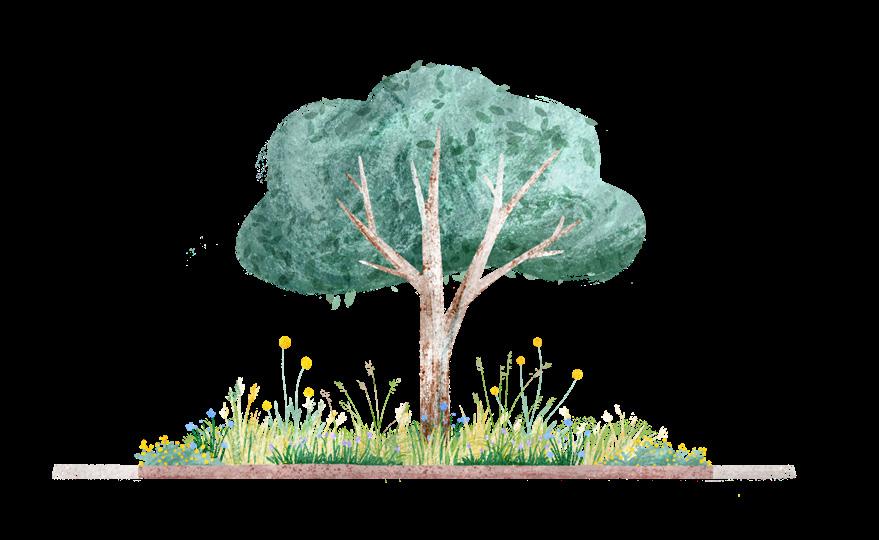wIldfloweR meaDOw GraSS aNd FaCt SHeet


Create a beautiful flowering grassland and wildflower native nature strip
The two dominant species in this design are the Kneed Wallaby Grass and Grey Tussock Grass. The Kneed Wallaby Grass is your low growing grass and the Grey Tussock Grass is the accent plant, providing height and interest through the centre of your nature strip.
Plant the wildflowers in blocks towards the edges of the grassland for maximum impact, so they create bold drifts of colour.

Chrysocephalum Common Everlasting
Kneed Wallaby Grass
Golden Billy Buttons
Tufted Bluebell
Native Flax
Tussock Grass
Driveway crossover
2m 5m 0.5m clearance
No dig root zone 0.5m radius
BIN BIN
Street tree trunk
Golden Billy Buttons (6)
Kneed Wallaby Grass (18)
Tussock Grass (7)
Native Flax (8)
Tufted Bluebell (15)
Road
Chrysocephalum Common Everlasting (6)
View from the street View from above. This will help you with planting
Footpath
recomMenDeD PlAntS
Based on average nature strip being five metres long by two metres wide, it is recommended to plant the following:
TUFTED BLUEBELL
Wahlenbergia communis
Height: 20cm
Width: 20cm
Sun: Full sun
Soil type: Dry, well-drained soil, summer moisture encourages denser growth and prolific flowering
Flowers and seed: Spreading perennial herb with thick taproots, self-seeds readily. Single bell shaped white, pale to bright blue flowers peaking Oct – May
Ecological role: Nectar plant for butterflies, flowers attract native bees
Maintenance: Rejuvenate by pruning severely in winter
COMMON EVERLASTING
Chrysocephalum apiculatum
Height: 20cm
Width: 50cm
Sun: Full sun, semi shade
Soil type: Most soil types, prefers well drained soil
Flowers and seed: Bright gold flowers all year
Ecological role: Nectar plant for butterflies
Maintenance: Prune late winter or early spring if required
Nature strip maintenance requirements: As per Hobsons Bay City Council guidelines, residents are required to maintain the nature strip adjacent to their property. This involves keeping it free of trip hazards, protruding objects and ensuring pathways, gutters and driveways are free of weeds, rubbish, and mulch. Scan to view the Nature Strip Landscape Guidelines
KNEED WALLABY GRASS
Rytidosperma geniculatum
Height: 30cm
Width: 40cm
Sun: Full sun, semi shade
Soil type: well drained sand and clay loam soils
Flowers and seed: Decorative small tussock with fine, green leaves. Buff coloured flowerheads in spring and summer
Ecological role: Bird attracting plant, food plant for caterpillars and preferred habitat for many butterflies and moths
Maintenance: Thrives on neglect, cut back late winter or early spring – never summer
TUSSOCK-GRASS
Poa species
Height: 40-50cm
Width: 50cm
Sun: Full sun, semi shade
Soil type: Prefers well drained soil, very adaptable
Flowers and seed: Lovely green or blue grass leaves. Grass flowerheads in spring and summer
Ecological role” Bird and butterfly attracting plant and food plant for caterpillars
Maintenance: Hard prune near the base combined with a rake to remove dead leaves
Indigenous poa include: Poa labillardieri, Poa poiformis and Poa sieberiana
NATIVE FLAX
Linum marginale
Height: 50cm
Width: 30cm


Sun: Full sun, semi shade
Soil type: Prefers moist, well drained soils
Flowers and seed: Lovely blue flowers most of the year, peaking Sep – March
Ecological role: Bird attracting berries
Maintenance: Cut back hard each year in late autumn to encourage vigorous new growth
GOLDEN BILLY BUTTONS
Pycnosorus chrysanthes
Height: 50cm
Width: 50cm
Sun: Full sun, semi shade
Soil type: Prefers heavy moist soils, tolerates waterlogging. Once established will tolerate dry periods
Flowers and seed: Bright yellow globular flowerheads held above the foliage
June – Dec. Wonderful cut flower, will maintain their colour when dried
Ecological role: Nectar plant for butterflies
Maintenance: Prune old stems after flowering in January
15 6 18 8 6 7
Recommended number of plants to buy Contact email habitatgardens@hobsonsbay.vic.gov.au
SCAN ME
meaDOw WIldfloweR FaCt SHeet
Create a beautiful flowering wildflower native nature strip
The hero plant of this design is the Dwarf Cushion Bush, a free-flowing shape defined by clusters of twos and threes. Its silver-grey foliage provides structure amongst the wildflowers.
This planting style seeks to recreate nature where plants of the same species are clumped together and rarely found in isolation.

Chrysocephalum Common Everlasting
Brachyscome Multifida Cut Leaf Daisy

 View from above. This will help you with planting
Dianella Brevicaulis Coast Flax Lily
View from above. This will help you with planting
Dianella Brevicaulis Coast Flax Lily
2m
Dwarf Cushion Bush
Driveway crossover
BIN BIN
5m
Street tree trunk No dig root zone 0.5m radius
Dwarf Cushion Bush (6)
Dianella Brevicaulis Coast Flax Lily (7)
Road
Chrysocephalum Common Everlasting (6) Brachyscome Mulitifida Cut Leaf Daisy (5)
0.5m clearance
Mulch
Footpath
recomMenDeD PlAntS
Based on average nature strip being five metres long by two metres wide, it is recommended to plant the following:
CUT LEAF DAISY
Brachyscome multifida
Height: 20cm
Width: 50cm
Sun: Full sun, semi shade
Soil type: Prefers moist clay soil, drought tolerant once established
Flowers and seed: Deep mauve daisy like flowers for most of the year, peaking Sep – March
Ecological role: Nectar plant for butterflies, useful soil binder
Maintenance: Clip old flowers to encourage a new flush of flowers mid-summer
COMMON EVERLASTING
Chrysocephalum apiculatum
Height: 20cm
Width: 50cm
Sun: Full sun, semi shade
Soil type: Most soil types, prefers well drained soil
Flowers: Bright gold flowers

all-year
Ecological role: Nectar plant for butterflies
Maintenance: Prune late winter or early spring if required
Nature strip maintenance requirements: As per Hobsons Bay City Council guidelines, residents are required to maintain the nature strip adjacent to their property. This involves keeping it free of trip hazards, protruding objects and ensuring pathways, gutters and driveways are free of weeds, rubbish, and mulch. Scan to view the Nature Strip Landscape Guidelines
COAST FLAX LILY
Dianella brevicaulis
Height: 50cm
Width: 50cm
Sun: Full sun, semi shade Soil type: Any, prefers well drained
Flowers and seed: Dark blue flowers Oct – Dec. Cobalt blue berries through summer
Ecological role: Bird attracting berries
Maintenance: Dianella do not need pruning for the first several years but will then benefit from a periodic prune. Prune to remove old flower spikes from the base of the plant once berries are finished in late autumn. Remove dead or yellowing leaves to keep plant looking tidy
DWARF CUSHION BUSH
Leucophyta nana
Height: 50cm
Width: 50cm


Sun: Full sun, semi shade
Soil type: Clay soil, rich composted soil, sandy soil, avoid wet sites
Flowers and seed: Small evergreen shrub with silver grey foliage and small yellow flowers Sep – Feb
Maintenance: Prune lightly if required
Please note: The native Dwarf Cushion Bush cultivar is compliant with the naturestrip height guidelines. The indigenous Cushion Bush Leucophyta brownie (1m High x 1m Wide) will required additional pruning
5 6 6 7 Recommended number of plants to buy Contact email habitatgardens@hobsonsbay.vic.gov.au
ME
SCAN
Throw your mower away and replace your lawn with these beautiful low maintenance indigenous plants.
The recommended plants in this design are selected for their toughness, adaptability and weed suppressing qualities.


The paired back plant palette creates a cohesive, tidy garden year-round with each plant creating its own seasonal interest through foliage and flower.
 View from above. This will help you with planting
Dianella Brevicaulis Coast Flax Lily
Creeping Myoporum Driveway crossover
View from above. This will help you with planting
Dianella Brevicaulis Coast Flax Lily
Creeping Myoporum Driveway crossover
2m BIN
5m Street
No dig root zone 0.5m radius Road 0.5m clearance Mulch
Chrysocephalum Common Everlasting
BIN
tree trunk
Dianella Brevicaulis Coast Flax Lily (8)
Chrysocephalum Common Everlasting (6)
Creeping Myoporum (5)
Footpath
recomMenDeD PlAntS
Based on average nature strip being five metres long by two metres wide, it is recommended to plant the following:
COAST FLAX LILY
Dianella brevicaulis
Height: 50cm
Width: 50cm
Sun: Full sun, semi shade
Soil type: Any, prefers well drained. Useful planted under Eucalyptus trees where little else will grow
Flowers and seed: Dark blue flowers Oct – Dec. Cobalt blue berries through summer
Ecological role: Bird attracting berries
Maintenance: Dianella do not need pruning for the first several years but will then benefit from a periodic prune. Prune to remove old flower spikes from the base of the plant once berries are finished in late autumn. Remove dead or yellowing leaves to keep plant looking tidy
Nature strip maintenance requirements: As per Hobsons Bay City Council guidelines, residents are required to maintain the nature strip adjacent to their property. This involves keeping it free of trip hazards, protruding objects and ensuring pathways, gutters and driveways are free of weeds, rubbish, and mulch. Scan to view the Nature Strip Landscape Guidelines SCAN ME
COMMON EVERLASTING
Chrysocephalum apiculatum
Height: 20cm
Width: 50cm
Sun: Full sun, semi shade Soil type: Most soil types, prefers well drained soil
Flowers: Bright gold flowers all year
Ecological role: Butterfly attracting
Maintenance: Prune late winter or early spring when the plant looks tired
CREEPING MYOPORUM
Myoporum parvifolium
Height: Prostrate
Width: 1-2m

Sun: Full sun, semi shade
Soil type: Prefers well drained soil, very adaptable. Hardy weed-suppressing groundcover tolerates light foot traffic
Flowers: Masses of white flowers Oct – Feb

Ecological role: Butterfly attracting, autumn fruit eaten by Rosellas
Maintenance: Prune late winter or early spring to prevent excessive growth and maintain a tidy appearance
TOO HARD?
Try our super minimalist design Replace your lawn with a single indigenous species for a low maintenance alternative that provides enormous benefits to our local wildlife.
LOMANDRA LONGIFOLIA
Spacing: four plants per m2
MYOPORUM PARVIFOLIUM
Spacing: two plants per m2
KENNEDIA PROSTRATA
Spacing: two plants per m2
5 6 8 Recommended number of plants to buy Contact email habitatgardens@hobsonsbay.vic.gov.au
minImalIST SUPer FaCt SHeet
Replacing your lawn with a single indigenous species is a low maintenance option which will provide enormous benefits to our local wildlife.
Creeping Myoporum and Running Postman are both beautiful flowering lawn replacements that never need mowing.
Repetitive planting of the Tanika complements the clean lines of modern homes.
recomMenDeD PlAntS
CREEPING MYOPORUM
Myoporum parvifolium
Spacing: 2 plants per m2
Height: Prostrate
Width: 1-2m


Sun: full sun, semi shade
Soil type: Prefers well drained soil, very adaptable. Hardy weed-suppressing groundcover tolerates light foot traffic.
Flowers: Masses of white flowers October – February
Ecological role: Butterfly attracting, autumn fruit eaten by Rosellas
Maintenance: Prune late winter or early spring to prevent excessive growth and maintain a tidy appearance.
Nature strip maintenance requirements: As per Hobsons Bay City Council guidelines, residents are required to maintain the nature strip adjacent to their property. This involves keeping it free of trip hazards, protruding objects and ensuring pathways, gutters and driveways are free of weeds, rubbish, and mulch. Scan to view the Nature Strip Landscape Guidelines
COAST FLAX LILY
Dianella brevicaulis
Height: 50cm
Width: 50cm
Sun: Full sun, semi shade
Soil type: Any, prefers well drained.
Flowers and seed: Dark blue flowers Oct – Dec. Cobalt blue berries through summer
Ecological role: Bird attracting berries
Maintenance: Dianella do not need pruning for the first several years but will then benefit from a periodic prune. Prune to remove old flower spikes from the base of the plant once berries are finished in late autumn. Remove dead or yellowing leaves to keep the plant looking tidy.
RUNNING POSTMAN
Kennedia prostrata
Spacing: 2 plants per m2
Height: Prostrate
Width: 1 – 2.5m
Sun: Full sun, semi shade
Soil type: Any, prefers well drained soil. Drought tolerant once established.
Flowers: Scarlet long-stemmed pea flowers August - December
Maintenance: Vigorous groundcover, prune late winter or early spring to prevent excessive growth and maintain a tidy appearance.
TANIKA
Lomandra longifolia
Spacing: 4 plants per m2
Height: 50cm
Width: 60cm
Sun: Full sun, semi shade
Soil type: Most soil types, requires good drainage, raise soil if planting in clay
Maintenance: Cut back 15cm above the ground every 3 – 10 years if required
Contact email habitatgardens@hobsonsbay.vic.gov.au
SCAN ME








 View from above. This will help you with planting
Dianella Brevicaulis Coast Flax Lily
Creeping Myoporum Driveway crossover
View from above. This will help you with planting
Dianella Brevicaulis Coast Flax Lily
Creeping Myoporum Driveway crossover